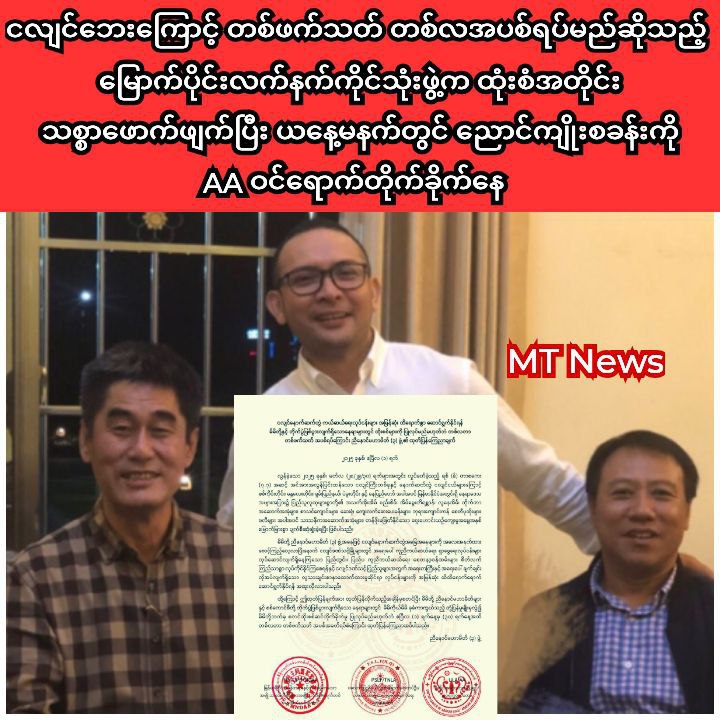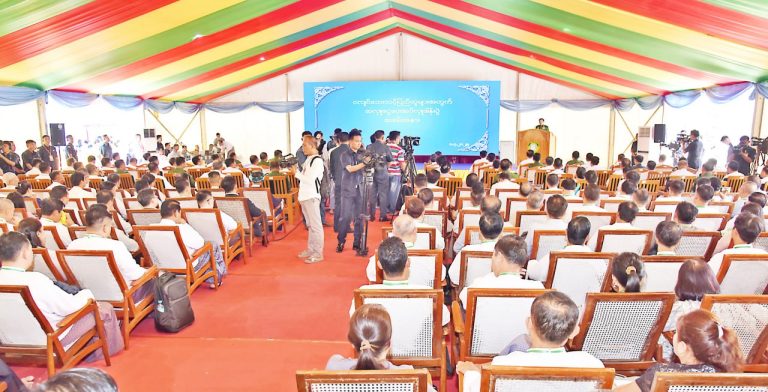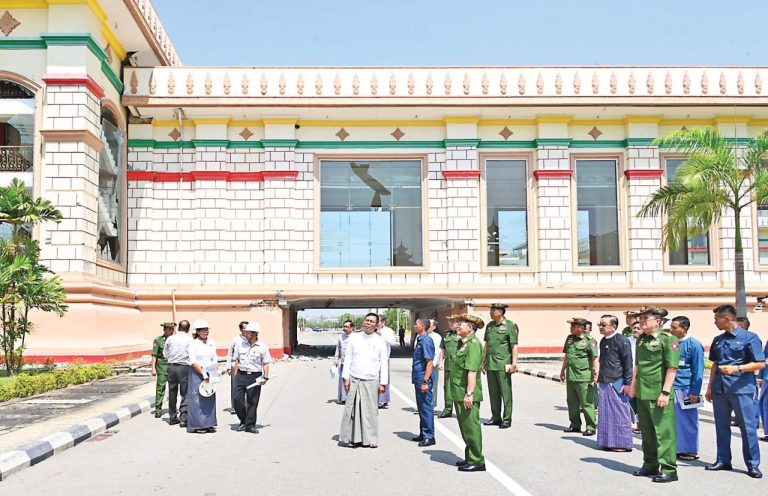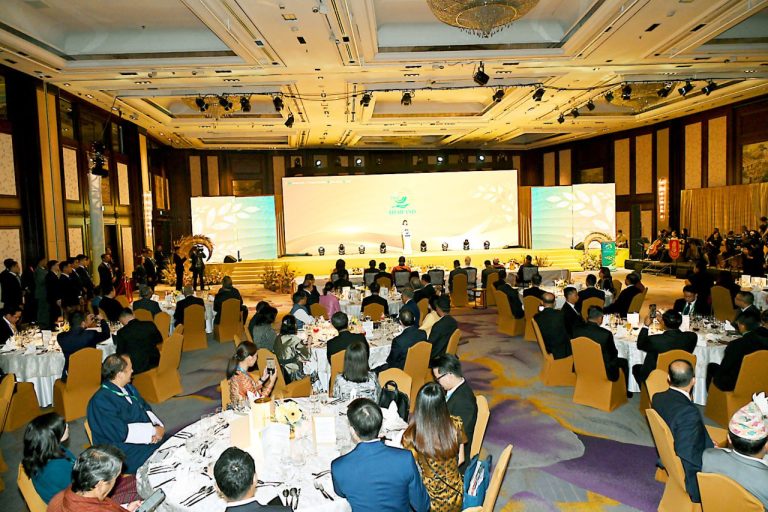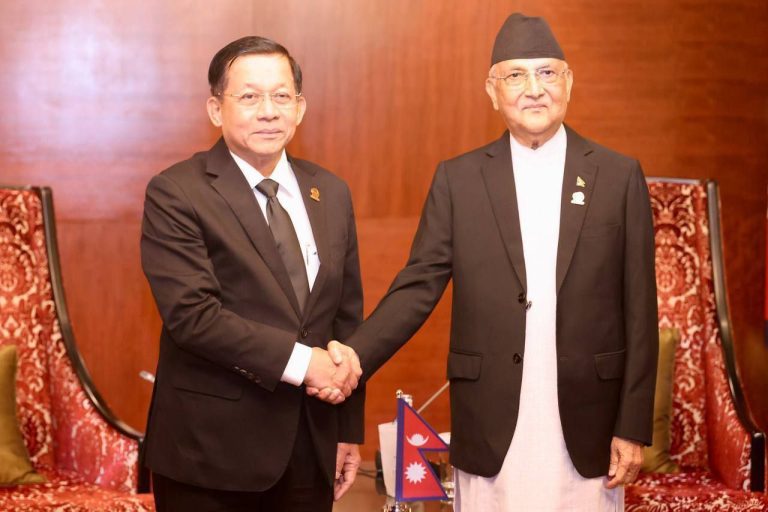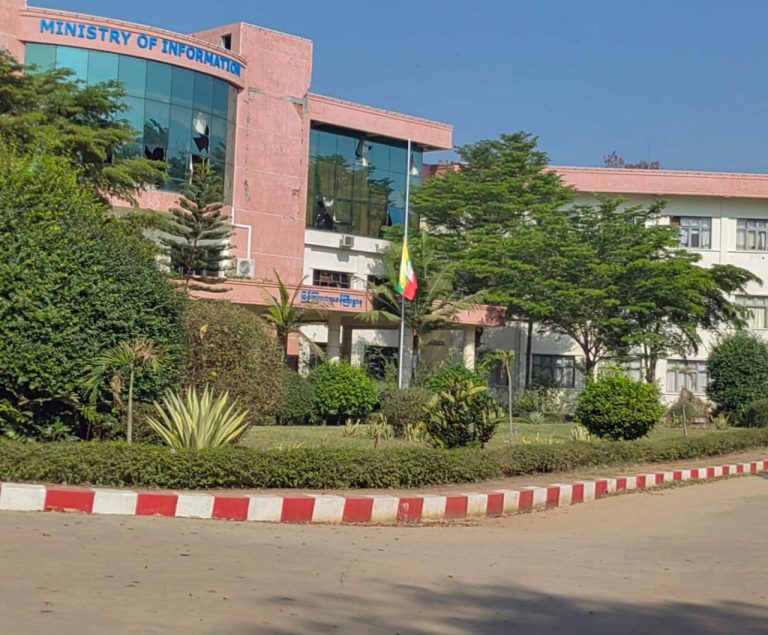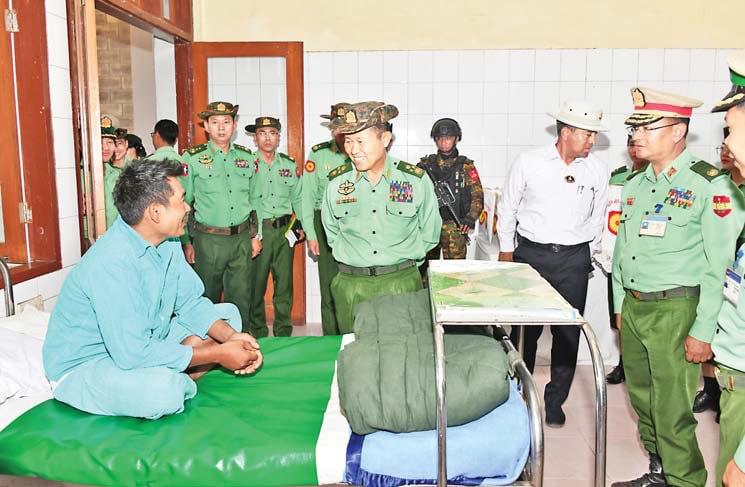
31 March 2025
As a powerful earthquake and aftershocks hit Sagaing Region, Mandalay Region, Magway Region, northeastern Shan State, Nay Pyi Taw Council Area and Bago Region on 28 March, destroying roads, bridges and buildings and killing and injuring people, search and rescue operations are being launched in respective states and regions.
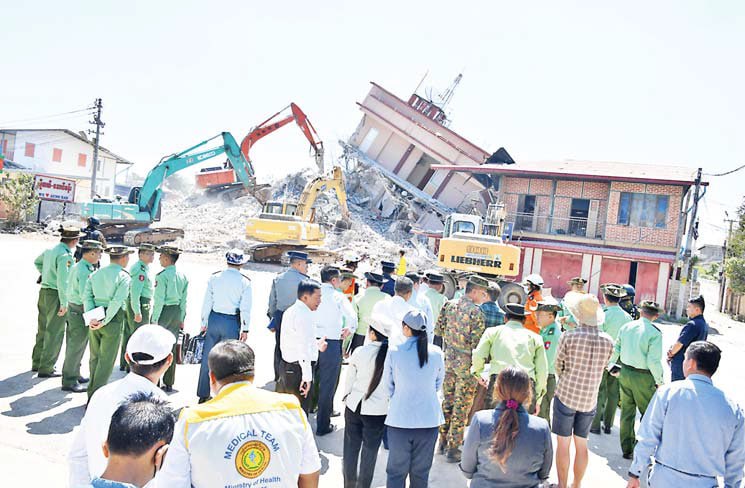

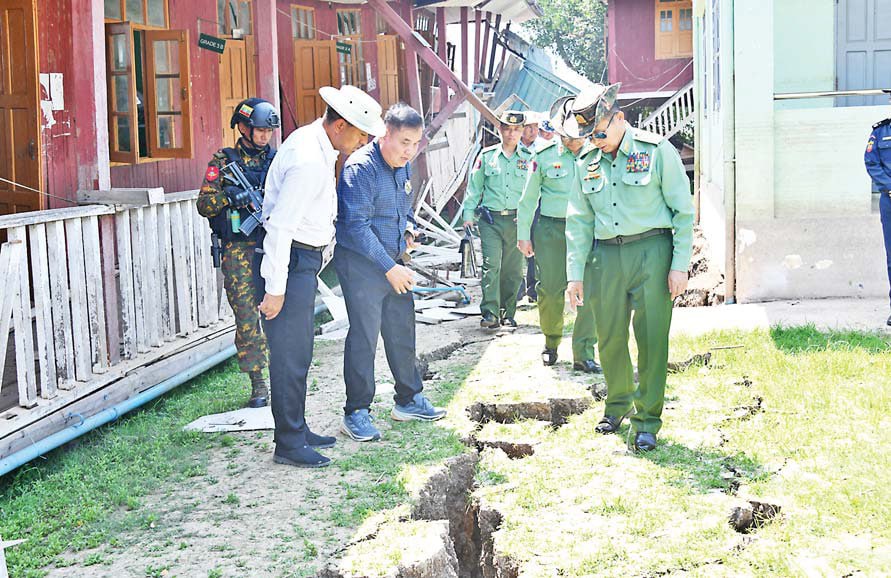
Chairman of the National Natural Disaster Management Committee Vice Chairman of the State Administration Council Deputy Prime Minister Vice-Senior General Soe Win, accompanied by senior military officers from the Office of the Commander-in-Chief, deputy ministers and officials, visited Aungban and Nyaungshwe in Shan State (South), inspected damage and extended sympathy to residents.
First, the Vice-Senior General and party arrived at Aung Ban and were greeted by the commander of the Eastern Command and officers.
Then, the Vice-Senior General and party inspected the relief and rescue operations with the use of heavy machinery at the Hotel Aung Ban, which was destroyed by the earthquake and gave necessary instructions to member of the Myanmar Engineering Council U Myo Myint, who was on a business trip to the township, and rescue teams and officials.
Then, the Vice-Senior General and party inspected the damage of the three-storey buildings of the Sasana Hitakayi Monastery and gave necessary instructions on urgent reconstruction of the building to facilitate the study of learner monks by engineers, designation of hazard zone near damaged buildings and other necessary issues.
Then, the Vice-Senior General and party paid obeisance to Presiding Sayadaw of the monastery Bhaddanta Pyinnya Vamsa and discussed matters related to repairing damaged buildings in the monastery as soon as possible, arrangements of food and betel nuts for monks and religious affairs before offering alms and cash donations to the Sayadaw. then, the Vice-Senior General and party inspected the Pitika Gonye Monastery and other religious buildings in the compound, the endurance of buildings in the monastery and gave necessary instructions to responsible officials.
It was learnt that 375 monks are studying in the monastery.
The Vice-Senior General and party visited the 28 civilians who were injured during the earthquake at the Aung Ban Defence Services Hospital and asked about their recovery warmly one by one before offering foodstuff to them. Then the Vice-Senior General inspected the drilling of a tube well for patients and local residents by Kanbawza Alin Organization for clean drinking water near the hospital before presenting cash assistance for the drilling team.
Then, the Vice-Senior General and party proceeded to Inlay by helicopter and boat and inspected damage due to the earthquake.
First, the Vice-Senior General and his delegation arrived at Kayla Village in Nyaungshwe Township, where they conducted a boat tour to assess the damage caused by the earthquake.
He then met with earthquake victims at the village monastery, where he explained that his visit was aimed at assessing the situation to facilitate necessary rescue, relief, and reconstruction efforts under the guidance of the Prime Minister.
He further explained that the rehabilitation efforts would begin with clearing debris from existing housing structures.
The process would be carried out step by step, including assessing the structural integrity of damaged residential and religious buildings, determining which ones can be repaired, demolishing those beyond repair, and swiftly restoring buildings with minimal damage.
He also addressed food and nutrition concerns, stating that basic food supplies and clean drinking water would be distributed.
Additionally, the State Rural and Cooperatives Department would deploy mobile water purification vehicles at the Nampan Marina Hotel Zone to ensure access to safe drinking water.
He also outlined the conditions for the continued distribution of international aid, the procedures for the National Disaster Management Committee in providing assistance and funds, and the plans to expedite the reopening of monasteries, schools, and clinics as soon as possible.
He emphasized that when damage inventory teams arrive to conduct assessments, complete and accurate information must be provided. Additionally, he outlined the conditions under which local residents would participate in the reconstruction efforts and contribute to other necessary assistance.
Additionally, he outlined the conditions under which local residents would participate in the reconstruction efforts and assist with other necessary tasks. He then coordinated and addressed the needs of the local residents based on their submissions, offering them warm greetings and words of encouragement.
He then visited and inspected the condition of the five 4-room apartment buildings (120 feet x 30 feet) at Kayla Village Basic Education High School (Sub-division), which had collapsed due to the earthquake.
He then coordinates and implements efforts to improve school facilities and learning conditions by the 2025-2026 academic year, working with the principal, officials, and engineers.
The Vice-Senior General and members next visited the earthquake-damaged monastery in Zayat Gyi Village, where they inspected the relief efforts being carried out by local military personnel, members of the Myanmar Police Force, and firefighters.
He then offered alms and nine-karma donations to the monastery’s abbot, Bhaddanta Sussadana. Additionally, he presented food and honorariums to the relief and rescue personnel.
The Vice-Senior General and members then visited the Inle Phaungdaw Oo Pagoda at the Yadanar San Monastery, where they offered flowers, water, and golden robes. They paid homage to Sayadaw Bhaddanta Wizaya and presented offerings and donations.
He then inspected the condition of the sun-shielding stone slabs in the pagoda’s courtyard, which had been cracked and damaged by the earthquake.
He also assessed the collapsed and damaged gates, stairs, Karaweik Pagoda, and other religious buildings. Additionally, he observed the machinery being used to improve the waterways and manage the silt in the surrounding lands, ensuring the long-term sustainability of Inle Lake and promoting a greener environment.
He then urged that the collapsed religious buildings be repaired as soon as possible, ensuring their original appearance is preserved.
This should be done in consultation with local state engineers and experts from the Myanmar Engineering Society.
He instructed officials to implement repairs and other necessary measures promptly to ensure that pilgrims can visit safely. He then visited local military personnel, Myanmar Police officers, and firefighters to assess the ongoing relief efforts, providing them with food and honorariums.
Based on preliminary inspections of the great temple of Inlay Phaung Taw Oo, where the Buddha sojourned, by engineers, officials from the State Irrigation Department, and geologists from the State Department of Natural Resources and Environmental Conservation, the stability of the main building of the temple is considered to be sound. It was noted that the area where the main staircase meets the main building on the north side has suffered slight damage. However, the remaining areas on the east, west, and south sides of the staircase and temple building were not originally connected, resulting in a gap of 3 to 6 inches.
It has been learned that there are cost-effective and efficient methods to address the situation.
The details of the repair work will be discussed by State-level Disaster Management Committee (DMC) members and experts, under the leadership of the state Chief Minister, and will be implemented as soon as possible.
The Vice-Senior General and members visited Nanpan-Inlay People’s Hospital in Nyaungshwe Township, where they were welcomed by hospital officials.
They checked on 18 earthquakeinjured civilians, inquired about their recovery, provided financial aid, and coordinated further assistance.
Then, the Vice-Senior General and members met with Statelevel disaster management organizations at the Eastern Command’s reception hall.
The Vice-Senior General said the meeting was held to learn about the policies set by the Prime Minister regarding the earthquake, to review the findings of this visit, and to formulate future plans.
On March 28, at 12:51:02 pm local time, the earthquake measuring 7.7 on the Richter scale struck about 20 kilometers northeast of Mandalay, about 21 kilometers northeast of the Mandalay Seismological Center.
The epicenter was very close, 10 kilometers below the ground, so it was very strong. As a result, a lot of damage was caused in Mandalay and Sagaing.
The Prime Minister has given the following priority: first, to clear away all the debris that was damaged by the earthquake as soon as possible; second, to safely and systematically demolish buildings that are currently in danger of being destroyed; third, in carrying out rehabilitation activities, the construction sector should learn from the earthquake damage and systematically carry out earthquake-resistant construction activities only after conducting ground inspections to ensure that roads, bridges, office buildings, and high-rise buildings are earthquake-resistant.
Private buildings that are not suitable for continued use should be demolished after consultation and systematically destroyed, and that government offices that are no longer suitable for continued use should be completely demolished.
In our country, due to natural disasters such as annual floods, storms, and earthquakes, the progress of the national development projects that the government must undertake is being delayed.
However, since it is a natural disaster and cannot be prevented in any way, the Vice-Senior General strongly urges the public to work together with relevant organizations and departments to carry out reconstruction work in the event of damage.
The Vice-Senior General highlighted that much of the damage in Aungban town, including high-rise buildings, resulted not from complete destruction but from tilting and partial sinking. The Vice- Senior General noted that last year’s Typhoon Yagi had already weakened the soil, exacerbating the impact of the recent earthquake.
The Vice-Senior General emphasized the need to learn from these incidents for future reconstruction efforts. Regarding the Inle area, the Vice-Senior General pointed out that houses built on wooden poles over water lacked solid foundations, leading to tilting over time.
When the earthquake struck, many structures collapsed into the water, causing numerous drownings. Unlike buildings on land, where rescue operations could retrieve the injured, water-based structures made rescues more difficult. In Shan State, the disaster destroyed 18 pagodas, three monasteries and nunneries, one bridge, and 157 residential buildings, resulting in 65 deaths and 73 injuries.
The Vice-Senior General expressed deep sorrow over the loss of human lives, emphasizing that while buildings can be rebuilt, human resources are an irreplaceable loss for the country’s future.
To minimize losses in future disasters, the Vice-Senior General urged collaborative efforts to ensure safer construction practices. In flood-prone areas, he stressed the importance of consulting with local residents and helping them build structures with balanced strength of the ground and weight distribution and strong foundations to withstand natural disasters.
The State-level Disaster Management Committee has been formed with various committees such as search and rescue, census, rehabilitation, education, and health, but especially in carrying out the census work, it would be more convenient to recruit and assign staff from other regions that are free from natural disasters rather than assigning staff from the earthquake-affected areas to the relevant departments.
The Prime Minister has also directed the officials to select and submit land for the construction of hospitals for the local people in Kayla Village Tract and Nanpan Village Tract, where the incident occurred.
Arrangements will be made to open a temporary hospital at Kayla Monastery. In addition, a special mobile medical team with specialists from Sao San Tun General Hospital and Tatmadaw Hospital No.2/700 will be sent from April 1. The death toll from the earthquake has reached over 2,000 nationwide.
The Prime Minister has invited neighboring countries and ASEAN countries to provide disaster relief assistance, and foreign countries have been actively involved in relief efforts.
Therefore, it is a matter of joy and gratitude to see that neighboring countries are providing humanitarian assistance to our country.
Therefore, in order to provide immediate relief to the people of Inle Lake, who are currently suffering from natural disasters, we urge them to work together with the leadership of the State DMC to actively participate in rehabilitation and moraleboosting activities.
The attendees discussed regional damage and losses, necessary measures, and support for earthquake-affected communities.
Key topics included temporary shelters, access to drinking water and electricity, distribution of basic food and DMC subsidies, swift reconstruction of schools, hospitals, and clinics, as well as tourist safety and security concerns.
The Vice-Senior General coordinated the necessary arrangements.

